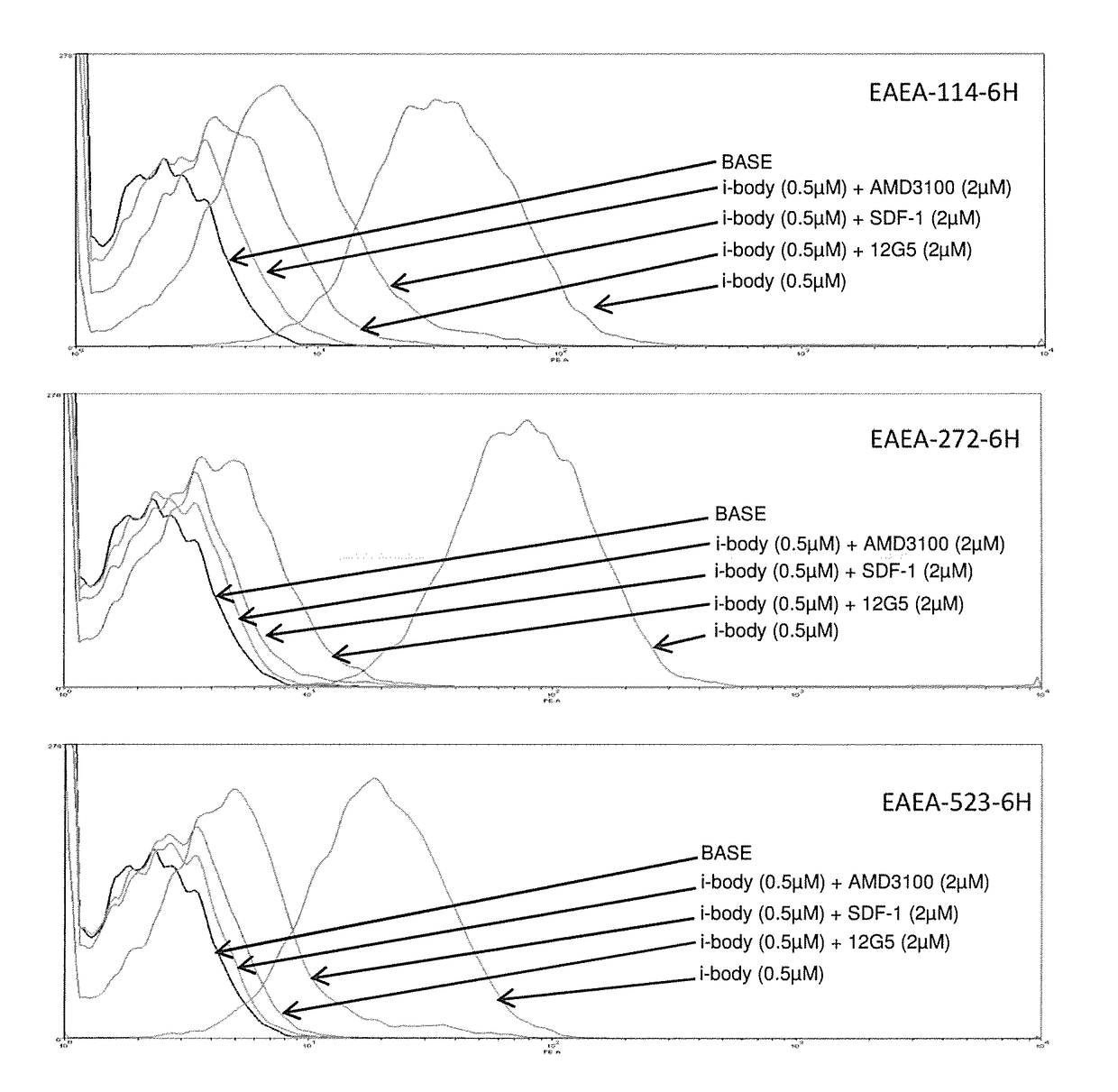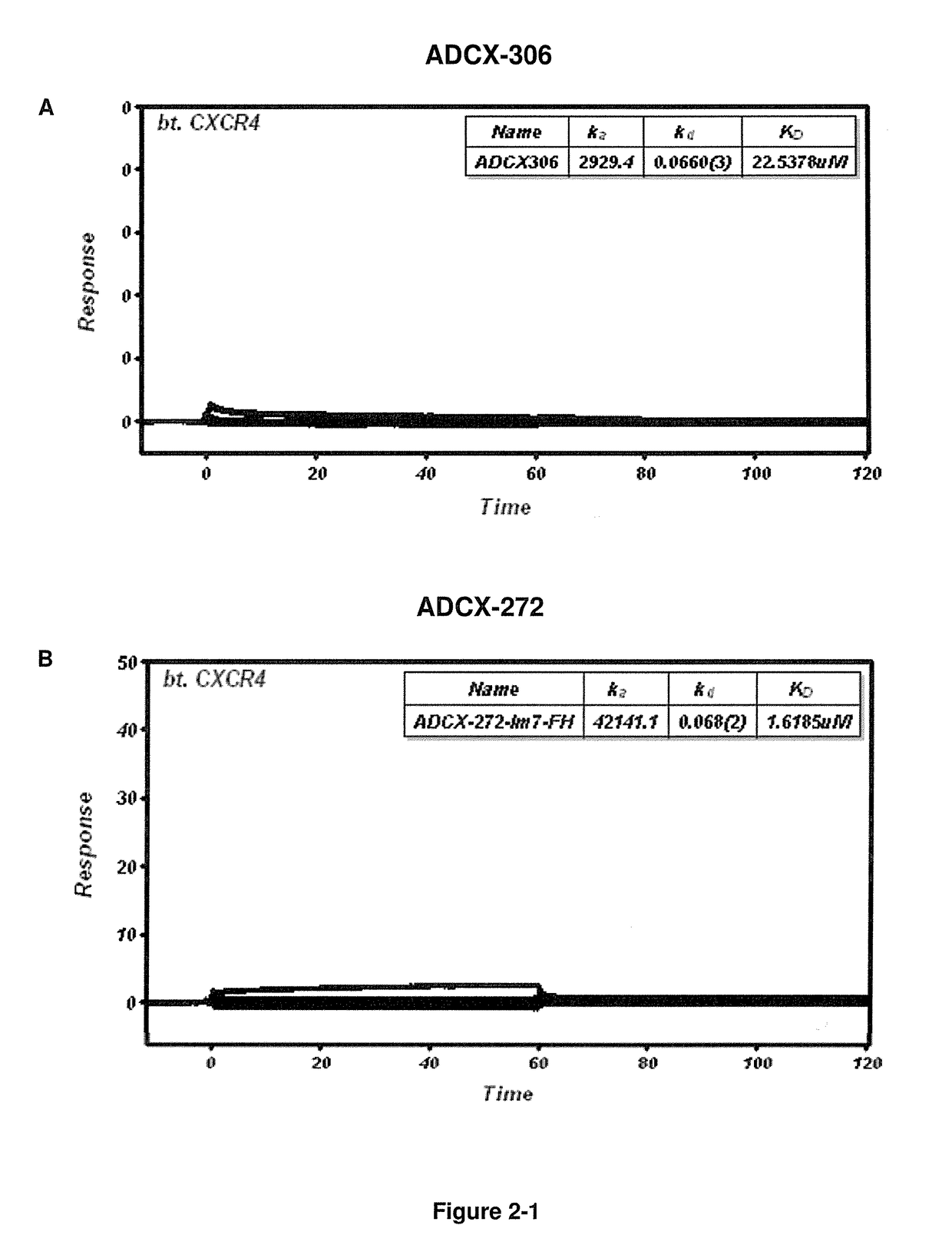Cxcr4 binding molecules
a technology of binding molecules and cxcr4, which is applied in the field of polypeptides, can solve the problems that the generation of high-quality antibodies or binding agents against membrane proteins is difficult to achieve using conventional means, and achieves the effects of low cost, high specificity, and high affinity
- Summary
- Abstract
- Description
- Claims
- Application Information
AI Technical Summary
Benefits of technology
Problems solved by technology
Method used
Image
Examples
example 1
ation of CXCR4 Blocking i-Bodies
[0435]The principles learnt from shark IgNAR antibody structures can be successfully applied to the generation of binding repertoires of human I-set domains from the immunoglobulin superfamily, which is further described in WO 2005 / 118629. Shark IgNAR antibodies are structurally close to the immunoglobulin superfamily of I-set domains such as Domain 1 of NCAM. The modified Domain 1 of NCAM is referred to as the i-body scaffold. Using this scaffold, a library of polypeptides is created and displayed on phage for screening against particular targets for specific binders to that target. Such libraries are anticipated to primarily contain variability in the CDR1 and CDR3 analogous regions.
[0436]An i-body library was created which had a random amino acid sequence in the CDR1 region (represented by XXXXXX in FIG. 1B) and in the CDR3 region (represented by Y′n in FIG. 1B), wherein n (the number of amino acids in the random CDR3 sequence) is varied randomly b...
example 2
isation of CXCR4 Blocking i-Bodies
[0444]2.1 I-Body Expression and Purification in E. coli
[0445]I-bodies were expressed and purified using an E. coli expression system. I-bodies were expressed with various affinity tags including E coli. immunity protein (Im7) FLAG and 6×HIS (designated Im7-FH in FIG. 4). I-bodies were purified from the periplasmic fraction and the cytoplasm using the various tags using anti-FLAG resin or Ni-NTA resin respectively. The results of size exclusion chromatography are shown in FIG. 4.
2.2 I-Body Expression and Purification in Pichia
[0446]Genes for the i-bodies were cloned into a Pichia expression vector. After some optimisation of clone selection, the protein titres ranged from 3-9 mg / L at the small (2 ml scale). At the fermentation scale the yields were between 26-150 mg / L. Further parameters such as (temperature, pH, feed rate and feed strategy) could be optimised at the fermentation level to improve yields. After large-scale expression and purificatio...
example 3
Maturation of i-Bodies
[0451]The i-body ADCX-99 was affinity matured using error prone PCR. This was carried out in two ways; either by creating a library of random mutations directed to the CDR1 and CDR3 or using an average of 2-3 nucleotide mutations anywhere in the sequence. The library was panned according to Henderson et al. (2007) Structure 15:1452-66. Using this strategy, the i-body ADCX-99 was modified in the CDR1 and / or the CDR3 regions to improve the affinity or expression to create a library of mutants.
3.1 Improvement to Expression Levels, Affinity and Specificity of i-Bodies
[0452]Ninety random mutant i-bodies of the affinity matured ADCX-99 were cultured in a 96 well plate. Analysis of periplasmic fractions showed protein expression and affinity levels varied significantly among the mutant clones. By comparison with ADCX-99, several mutant clones were better expressers than the wild-type ADCX-99 i-body (FIG. 6).
[0453]When the same ninety clones were then examined for bind...
PUM
 Login to View More
Login to View More Abstract
Description
Claims
Application Information
 Login to View More
Login to View More - R&D
- Intellectual Property
- Life Sciences
- Materials
- Tech Scout
- Unparalleled Data Quality
- Higher Quality Content
- 60% Fewer Hallucinations
Browse by: Latest US Patents, China's latest patents, Technical Efficacy Thesaurus, Application Domain, Technology Topic, Popular Technical Reports.
© 2025 PatSnap. All rights reserved.Legal|Privacy policy|Modern Slavery Act Transparency Statement|Sitemap|About US| Contact US: help@patsnap.com



